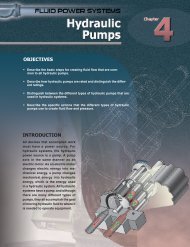Vibration Analysis and the Global Skill Shortage - Plant Services
Vibration Analysis and the Global Skill Shortage - Plant Services
Vibration Analysis and the Global Skill Shortage - Plant Services
Create successful ePaper yourself
Turn your PDF publications into a flip-book with our unique Google optimized e-Paper software.
<strong>Vibration</strong> <strong>Analysis</strong> <strong>and</strong><br />
<strong>the</strong> <strong>Global</strong> <strong>Skill</strong> <strong>Shortage</strong><br />
Can training catch up to technology?<br />
Special Report
In many industries, <strong>the</strong> cost of<br />
turnarounds <strong>and</strong> overhauls is<br />
still one of <strong>the</strong> primary<br />
operating expenses.<br />
Each business has always had a few key machines, usually rotary, that absolutely, positively had<br />
to run. The reasons may have been economic, safety-related or ecological, but <strong>the</strong>y were nonnegotiable.<br />
Prior to condition-based maintenance technology, key machines were usually taken<br />
out of service <strong>and</strong> overhauled well before mean time between failures (MTBF) would have predicted<br />
that <strong>the</strong>y would break. During <strong>the</strong> overhaul <strong>the</strong> business may have been out of operation, but this<br />
was usually preferable to surprise failures <strong>and</strong> <strong>the</strong> peripheral damage <strong>the</strong>y would cause.<br />
In many industries, <strong>the</strong> cost of turnarounds <strong>and</strong> overhauls is still one of <strong>the</strong> primary operating<br />
expenses. For many it ranks immediately behind production materials <strong>and</strong> labor. Time-based shutdowns<br />
are designed to occur before any equipment damage occurs, but to do so <strong>the</strong>y apply wide<br />
safety margins to <strong>the</strong> expected life of <strong>the</strong> equipment. This means that <strong>the</strong>y waste a major portion<br />
of equipment life in order to avoid breakdowns. There had to be a better way than scheduling<br />
overhauls before <strong>the</strong>y were needed.<br />
Given this situation, <strong>the</strong> ability to predict equipment failure long enough before it occurred to<br />
schedule appropriate maintenance without wasting a great deal of equipment life became <strong>the</strong> Holy<br />
Grail of maintenance engineering. Over time, <strong>the</strong> engineers who pursued this objective came to be<br />
known as reliability engineers in recognition of <strong>the</strong> fact that <strong>the</strong>ir mission was to prevent failures<br />
ra<strong>the</strong>r than correct <strong>the</strong>m. “Detect to prevent” became a watchword of reliability professionals.<br />
Condition Monitoring Tools<br />
During <strong>the</strong> last quarter of <strong>the</strong> 20th century several groups of condition monitoring tools came into<br />
more <strong>and</strong> more general use in industry. These tools included chemical analysis of lubricants <strong>and</strong><br />
coolants, <strong>the</strong>rmographic analysis of heat sources, ultrasonic analysis of moving equipment <strong>and</strong> material<br />
flows, <strong>and</strong> vibration analysis. As <strong>the</strong> tools developed, <strong>the</strong>ir value increased. Technicians became<br />
better <strong>and</strong> better at predicting equipment failures <strong>and</strong> scheduling work around <strong>the</strong>m. The science<br />
of preventing surprise failures was well underway. It was possible to plan maintenance in advance of<br />
catastrophic failure. Individual failed components could be replaced instead of whole systems that<br />
were destroyed because a motor or a bearing had broken down, taking a system with it.<br />
As great an improvement as <strong>the</strong>se condition monitoring tools provided, most were still monitoring<br />
equipment degradation. When oil <strong>and</strong> coolant samples began to show metal filings or<br />
water contamination in lubricants, damage to systems was already underway. When <strong>the</strong>rmography<br />
showed hot spots from leaks or faulty contacts, <strong>the</strong> damage had already begun. When<br />
ultrasound showed <strong>the</strong> shrill sound of a leak or <strong>the</strong> grinding of a distressed bearing, a breakdown<br />
was in progress. In all three cases, equipment failure was usually inevitable once <strong>the</strong> signals were<br />
received. The element of surprise was reduced or eliminated, dramatically improving <strong>the</strong> technical<br />
<strong>and</strong> economic picture, but a repair would still be necessary.<br />
<strong>Vibration</strong> <strong>Analysis</strong> & <strong>the</strong> <strong>Global</strong> <strong>Skill</strong> <strong>Shortage</strong> | 2
<strong>Vibration</strong> analysis can frequently<br />
provide information necessary to<br />
prevent equipment degradation<br />
prior to any damage occurring.<br />
<strong>Vibration</strong> analysis can frequently provide information necessary to prevent equipment degradation<br />
prior to any damage occurring. For equipment that is subject to a wide variety of mechanical<br />
problems, <strong>the</strong> presence of forces that would damage equipment can often be detected <strong>and</strong> rectified<br />
before <strong>the</strong>y can cause damage. Here, <strong>the</strong>n, for a great deal of key equipment is <strong>the</strong> Holy Grail<br />
supporting <strong>the</strong> detect-to-prevent approach to reliability.<br />
The potential problems detectable by vibration analysis include alignment <strong>and</strong> balance issues<br />
that will destroy couplings <strong>and</strong> bearings. Harmonic <strong>and</strong> sympa<strong>the</strong>tic vibrations that will undermine<br />
foundations <strong>and</strong> welded structures can also be identified <strong>and</strong> corrected. Uneven forces that<br />
distort motor <strong>and</strong> drive mountings come to light. Loose iron in new motors, nicked gear teeth or<br />
improper gear meshing can all be identified while <strong>the</strong>y are still <strong>the</strong> responsibility of OEM providers.<br />
Poorly anchored frames <strong>and</strong> piping, improper shimming <strong>and</strong> <strong>the</strong>rmal growth can be identified <strong>and</strong><br />
prevented from damaging equipment.<br />
All of <strong>the</strong>se countermeasures are especially effective when used in a new installation before or<br />
immediately after commissioning. This is also <strong>the</strong> stage when baseline readings should be taken<br />
for future comparison to condition monitoring output.<br />
Brief History of <strong>Vibration</strong> <strong>Analysis</strong><br />
“During <strong>the</strong> mid-1970s <strong>and</strong> early 1980s vibration analysis technology was introduced into commercial<br />
industry <strong>and</strong> was proven to be able to identify faults in rotating machinery,” reports Dean<br />
Lofall, a 33 year veteran of vibration analysis <strong>and</strong> condition monitoring technologies, today <strong>the</strong><br />
director, marketing <strong>and</strong> communications at <strong>the</strong> Mobius Institute (www.mobiusinstitute.com).<br />
“Test equipment was very expensive; spectrum analyzers, tape recorders, charge <strong>and</strong> voltage mode<br />
amplifiers, x-y plotters. Mostly engineering consulting companies <strong>and</strong> staff engineers conducted<br />
one-off tests on machines. Only a few implementations included routine testing of equipment.<br />
“At this time DLI Engineering implemented <strong>the</strong> largest program at <strong>the</strong> time on all U.S. Navy<br />
aircraft carriers, developing <strong>the</strong> first triaxial vibration sensor. The program tested about 300<br />
machines on each of 15 ships, totaling about 4,500 machines monitored on a regular basis. The<br />
Navy demonstrated a 15:1 benefit to cost ratio,” he says.<br />
By 1985, vibration analysis technology had moved to digital data collectors, <strong>and</strong> basic PC vibration<br />
analysis software, explains Lofall. “This allowed <strong>the</strong> technology to be delivered broadly to<br />
plants, but PCs were not yet widely used in plant engineering departments, so vibration technology<br />
training often included PC training for maintenance departments,” he says. Early adopters were<br />
mostly Fortune 500 manufacturing companies <strong>and</strong> major power generation companies.<br />
“A few individuals excelled at <strong>the</strong> new technology <strong>and</strong> were highly regarded amongst <strong>the</strong>ir peers<br />
<strong>and</strong> by plant management,” says Lofall. “The technology was still not widely embraced but it was<br />
making strides in being recognized as valuable.”<br />
<strong>Vibration</strong> <strong>Analysis</strong> & <strong>the</strong> <strong>Global</strong> <strong>Skill</strong> <strong>Shortage</strong> | 3
Approximately 70% of<br />
rotating machines benefit<br />
from vibration analysis.<br />
By 1990 acceptance was growing, but a majority of plants still did not participate, continues<br />
Lofall. At this time predictive maintenance was still <strong>the</strong> focus in most plants, <strong>and</strong> it was pushed<br />
by vibration vendors in order to sell products. Most plants still focused on time-based preventive<br />
maintenance (PM) practices.<br />
“The individuals who excelled at vibration analysis technology, were highly in dem<strong>and</strong> at this<br />
point, <strong>and</strong> <strong>the</strong> first wave of experts left <strong>the</strong> practice,” recalls Lofall. In <strong>the</strong> plant <strong>the</strong>se “stars” tended<br />
to be promoted out of <strong>the</strong>ir positions <strong>and</strong> into management. Many o<strong>the</strong>rs saw <strong>the</strong> emerging<br />
technology as a business opportunity. By purchasing a $30,000 system <strong>the</strong>y could go into business<br />
<strong>and</strong> provide consulting services to <strong>the</strong>ir former plants <strong>and</strong> o<strong>the</strong>r customer sites. The vibration<br />
consultancy business was born.<br />
“With <strong>the</strong> great number of experts leaving <strong>the</strong> manufacturing industry, a vacuum of need was<br />
created,” says Lofall. “As a result, many new vibration analysts were entering <strong>the</strong> trade, <strong>and</strong> much<br />
of <strong>the</strong> training <strong>the</strong>y received was provided by vibration product vendors <strong>and</strong> a few vibration analysis<br />
training companies. Most of this training focused on <strong>the</strong>ory <strong>and</strong> use of specific equipment<br />
<strong>and</strong> software. Since most experienced analysts had risen out of technical positions, several years<br />
passed before analysts developed practical skills <strong>and</strong> advanced analysis capabilities.”<br />
By <strong>the</strong> early 2000s, acceptance of predictive maintenance (PdM) <strong>and</strong> vibration analysis was<br />
spreading across industry. New vibration analysis vendors were emerging in <strong>the</strong> marketplace.<br />
Where once only about a half dozen vendors had been providing vibration analysis, many more<br />
were now in <strong>the</strong> market.<br />
“Early vendors like CSI, Entek, Palomar, <strong>and</strong> DLI were bought by large companies such as<br />
Emerson, Rockwell, SKF, <strong>and</strong> ABB,” explains Lofall. “These acquisitions proved not to be very successful,<br />
providing more opportunity for newer companies on <strong>the</strong> l<strong>and</strong>scape to gain market share.”<br />
The new companies helped to increase <strong>the</strong> visibility of vibration analysis in <strong>the</strong> market, <strong>and</strong> drive<br />
down <strong>the</strong> entry capital cost, thus continuing its expansion.<br />
By this time, <strong>the</strong> concepts of condition monitoring had broadened. Oil analysis, while still<br />
done in specialized labs, had become more affordable in cost per sample, <strong>and</strong> ferrography (wear<br />
particle analysis) was gaining hold. Infrared <strong>the</strong>rmography equipment was starting to become<br />
affordable <strong>and</strong> was mostly used in finding electrical faults with motors, controllers, load centers,<br />
<strong>and</strong> wiring connections. The market for condition monitoring was continuing to exp<strong>and</strong>, with<br />
many sites having little experience on <strong>the</strong>ir staffs.<br />
<strong>Vibration</strong> <strong>Analysis</strong> & <strong>the</strong> <strong>Global</strong> <strong>Skill</strong> <strong>Shortage</strong> | 4
“Success of a vibration<br />
program is <strong>the</strong> responsibility<br />
of plant managers.”<br />
“The recession of 2000 caused many condition monitoring programs to be put on hold or<br />
terminated due to budget reduction,” explains Lofall. “<strong>Skill</strong>ed analysts were transferred or lost.<br />
Upon recovery of this period, new members entered into condition monitoring with <strong>the</strong> challenge<br />
of gaining meaningful experience ahead of <strong>the</strong>m.”<br />
Current Technical Status of <strong>Vibration</strong> <strong>Analysis</strong><br />
“<strong>Vibration</strong> analysis has <strong>the</strong> widest application of all condition monitoring tools, but it is also <strong>the</strong><br />
most complex,” says Lofall. Approximately 70% of rotating machines benefit from vibration analysis,<br />
as compared to about 30% of rotating machines benefit from oil analysis, he explains.<br />
Today <strong>the</strong> vibration analysis market has been fairly well developed <strong>and</strong> <strong>the</strong> tools have been<br />
widely deployed. Most plants have programs at some level. But <strong>the</strong> world financial crisis has also<br />
had an impact on vibration analysis. Reduced manufacturing output <strong>and</strong> reduced budgets have<br />
caused many programs to be terminated. <strong>Skill</strong>ed technicians have once more been moved to o<strong>the</strong>r<br />
roles in <strong>the</strong> plant. This is largely due to <strong>the</strong> fact that near-term savings are being favored at <strong>the</strong> expense<br />
of long term increased maintenance cost. “Hard times tend to breed short-sighted decision<br />
making,” says Lofall.<br />
Elements of a valid <strong>Vibration</strong> <strong>Analysis</strong> Program<br />
“Success of a vibration program is <strong>the</strong> responsibility of plant managers,” asserts Jason Tranter,<br />
managing director <strong>and</strong> founder of Mobius Institute (www.mobiusinstitute.com). “Having welltrained<br />
<strong>and</strong> competent analysts at your plant is only one component of your program’s success.<br />
Include operators in your program who have a close relationship with <strong>the</strong> machines <strong>and</strong> <strong>the</strong><br />
processes <strong>the</strong>y serve. Managers must allow <strong>the</strong> program to get <strong>the</strong> appropriate time, attention,<br />
<strong>and</strong> resources it needs. But with that, management must encourage a detect-to-prevent mindset<br />
that analysts always engage in root cause analyses to support <strong>the</strong> greater goal of improving equipment<br />
reliability. By having a great analytical staff <strong>and</strong> addressing tomorrow’s problems today, your<br />
plant will enjoy a successful program that realizes good ROI through decreased maintenance costs<br />
<strong>and</strong> higher availability.”<br />
Staffing for <strong>Vibration</strong> <strong>Analysis</strong><br />
During each of <strong>the</strong> three reductions in skilled <strong>and</strong> experienced vibration analysts in 1990, 2000,<br />
<strong>and</strong> 2010, new analysts were trained in <strong>the</strong> <strong>the</strong>ory <strong>and</strong> use of vibration analysis equipment, reports<br />
Lofall. However, in many cases, experienced analysts who would have provided mentorship<br />
<strong>and</strong> help to new analysts were lost.<br />
<strong>Vibration</strong> <strong>Analysis</strong> & <strong>the</strong> <strong>Global</strong> <strong>Skill</strong> <strong>Shortage</strong> | 5
“Not only will vibration teams<br />
lose skilled workers directly to<br />
retirement, but younger vibration<br />
analysts will be moved to replace<br />
retirees in o<strong>the</strong>r mechanical skills.”<br />
“Nothing can replace <strong>the</strong> voice of experience. Just as medical interns benefit from training with<br />
working doctors, <strong>the</strong>se vibration analysis pioneers would have been invaluable in <strong>the</strong> development<br />
of <strong>the</strong> new analysts’ capabilities,” says Lofall. “The aging workforce has also begun retiring in great<br />
numbers. The first baby boomers, born in 1943, will be 70 in 2013. They have begun an exodus<br />
that will take an important share of U.S. industrial knowledge with <strong>the</strong>m. As <strong>the</strong> exodus continues,<br />
not only will vibration teams lose skilled workers directly to retirement, but younger vibration<br />
analysts will be moved to replace retirees in o<strong>the</strong>r mechanical skills.”<br />
A 2011 report from Deloitte <strong>and</strong> <strong>the</strong> Manufacturing Institute entitled “Boiling Point? The <strong>Skill</strong>s<br />
Gap in U.S. Manufacturing” (http://www.plantservices.com/industrynews/2011/Manufacturing-<br />
Institute-Deloitte-skills-gap-report.html) provides more interesting insights into <strong>the</strong> labor situation<br />
<strong>and</strong> its impact on <strong>the</strong> need for highly skilled manufacturing workers. The survey polled a sample of<br />
1,123 U.S. manufacturing executives <strong>and</strong> found that <strong>the</strong> shortage of vibration analysis technicians<br />
is part of a nationwide pattern. Report highlights follow.<br />
Survey findings are consistent with previous skills-gap studies, with 67% of respondents reporting<br />
a moderate to severe shortage of available, qualified workers <strong>and</strong> 56% anticipating <strong>the</strong><br />
shortage to grow worse in <strong>the</strong> next three to five years, according to <strong>the</strong> report. In addition, <strong>the</strong><br />
survey indicates that 5% of current jobs at respondent manufacturers are unfilled due to a lack of<br />
qualified c<strong>and</strong>idates.<br />
When asked to look ahead three to five years, respondents indicated that access to a highly<br />
skilled, flexible workforce is <strong>the</strong> most important factor in <strong>the</strong>ir effectiveness, ranked above factors<br />
such as new product innovation <strong>and</strong> increased market share by a margin of 20 percentage points.<br />
The hardest jobs to fill are those that have <strong>the</strong> biggest impact on performance. <strong>Shortage</strong>s in<br />
skilled production jobs — machinists, operators, craft workers, distributors, <strong>and</strong> technicians — are<br />
taking <strong>the</strong>ir toll on manufacturers’ ability to exp<strong>and</strong> operations, drive innovation, <strong>and</strong> improve productivity.<br />
Seventy-four percent of respondents indicated that workforce shortages or skills deficiencies<br />
in skilled production roles are having a significant impact on <strong>the</strong>ir ability to exp<strong>and</strong> operations<br />
or improve productivity. Unfortunately, <strong>the</strong>se jobs require <strong>the</strong> most training, <strong>and</strong> are traditionally<br />
among <strong>the</strong> hardest manufacturing jobs to find existing talent to fill, according to <strong>the</strong> report.<br />
High unemployment is not making it easier to fill positions, particularly in <strong>the</strong> areas of skilled<br />
production <strong>and</strong> production support. There’s no way around it: survey respondents report, on<br />
median, that 5% of <strong>the</strong>ir jobs remain unfilled simply because <strong>the</strong>y can’t find people with <strong>the</strong> right<br />
skills. Translated to raw numbers, this means that as many as 600,000 jobs are going unfilled, a<br />
remarkable fact when <strong>the</strong> country is facing an unemployment rate that hovers above 9%. Respondents<br />
separately report that <strong>the</strong> national education curriculum is not producing workers with <strong>the</strong><br />
basic skills <strong>the</strong>y need.<br />
<strong>Vibration</strong> <strong>Analysis</strong> & <strong>the</strong> <strong>Global</strong> <strong>Skill</strong> <strong>Shortage</strong> | 6
WEBINAR<br />
Condition Monitoring <strong>and</strong> Predictive Maintenance<br />
http://www.ilearn-online.com/promomovies/CBM-Benefits/CBM-Benefits_controller.swf<br />
This one hour presentation that summarizes<br />
four maintenance strategies <strong>the</strong>n<br />
looks more closely at condition monitoring<br />
<strong>and</strong> predictive maintenance. The benefits of<br />
precision maintenance are described <strong>and</strong> <strong>the</strong>n<br />
illustrated. Along <strong>the</strong> way <strong>the</strong> presentation discusses <strong>the</strong> famous<br />
bathtub curve <strong>and</strong> introduces OEE.<br />
http://www.mobiusinstitute.com/flightschool<br />
Like flight simulation is to a pilot,<br />
Analyst Flight School is a bridge<br />
between training <strong>and</strong> becoming<br />
an experienced analyst. The<br />
actual machines fault<br />
scenarios delivered in a<br />
stress-simulated plant<br />
environment, provides<br />
you new abilities to<br />
solve real-world <strong>and</strong><br />
difficult machine<br />
diagnostic problems.<br />
Clearly, many manufacturers are investing in training programs. But <strong>the</strong> evidence suggests that<br />
<strong>the</strong>se programs are falling short of <strong>the</strong>ir goals. Two-thirds of <strong>the</strong> respondents said <strong>the</strong>y’re relying<br />
on overtime, while nearly half used third-party labor to close <strong>the</strong> skill gaps. These methods are<br />
costly, inefficient, <strong>and</strong> can add up to a big drag on overall performance. The responses to this<br />
question are remarkably consistent across industry groups, indicating a need across <strong>the</strong> board to<br />
embrace more analytical <strong>and</strong> innovative means of dealing with skills gaps.<br />
Manufacturers face challenges in o<strong>the</strong>r technical job classifications such as engineering technologists<br />
<strong>and</strong> scientists, with moderate to severe shortages at 60% <strong>and</strong> 50% of surveyed companies,<br />
respectively. Again, <strong>the</strong> situation for <strong>the</strong>se employment categories is expected to worsen in<br />
<strong>the</strong> near term. This will present a serious problem in a few years as more <strong>and</strong> more workers retire;<br />
75% of respondents indicated that pending retirements <strong>and</strong> an aging workforce will have <strong>the</strong> most<br />
significant impact among skilled production workers, with 40% saying it will be significant for<br />
production support, according to <strong>the</strong> report.<br />
Exacerbating <strong>the</strong> issue is <strong>the</strong> stubbornly poor perception of manufacturing jobs among younger<br />
workers. Deloitte’s public opinion survey on manufacturing found that among 18-to-24-year-olds,<br />
manufacturing ranks dead last among industries in which <strong>the</strong>y would choose to start <strong>the</strong>ir careers.<br />
Combined with <strong>the</strong> results above, this leaves <strong>the</strong> manufacturing industry with some steep challenges<br />
related to business operations. Over 70% of respondents indicate an increase or no change<br />
over <strong>the</strong> past five years in how <strong>the</strong> current skills shortage negatively impacts critical functions like<br />
new product development, implementation of new technologies, or attaining productivity targets,<br />
according to <strong>the</strong> Deloitte/Manufacturing Institute report.<br />
Experienced vibration analysis technicians are in short supply now, <strong>and</strong> will probably stay<br />
that way for <strong>the</strong> foreseeable future. This suggests that trying to hire <strong>the</strong> talent needed to support<br />
major vibration analysis programs will probably create a bottleneck in <strong>the</strong> deployment of<br />
this important technology.<br />
It is also true that, before any technician can be truly effective in a manufacturing setting, he<br />
or she must achieve an underst<strong>and</strong>ing of <strong>the</strong> manufacturing operation <strong>and</strong> its products. This suggests<br />
that a more productive approach might be to recruit talented manufacturing <strong>and</strong> tradespeople<br />
from <strong>the</strong> existing organization <strong>and</strong> provide <strong>the</strong>m with <strong>the</strong> training <strong>and</strong> mentoring relationships<br />
that help develop <strong>the</strong>m into vibration analysis professionals.<br />
References<br />
http://www.plantservices.com/industrynews/2011/Manufacturing-Institute-Deloitte-skills-gap-report.html<br />
http://www.plantservices.com/multimedia/MMA/Mobius-supercharge-vibration-program.pdf<br />
<strong>Vibration</strong> <strong>Analysis</strong> & <strong>the</strong> <strong>Global</strong> <strong>Skill</strong> <strong>Shortage</strong> | 7
Sponsored by<br />
MOBIUS INSTITUTE<br />
ISO/IEC 17024 Accredited <strong>Vibration</strong><br />
<strong>Analysis</strong> Certification per ISO 18436<br />
http://marketing.mobiusinstitute.com/acton/<br />
attachment/2278/f-009e/0/-/-/-/-/file.pdf<br />
Mobius Institute provides unique <strong>and</strong><br />
easily underst<strong>and</strong>able vibration analysis<br />
training <strong>and</strong> certification to Predictive<br />
Maintenance (PdM) technicians <strong>and</strong><br />
Reliability Engineers, allowing companies<br />
to operate at higher levels of availability <strong>and</strong> profitability.<br />
VIDEO<br />
Learn About Mobius Institute<br />
Training & Certification<br />
http://youtu.be/UlvaK54thMQ<br />
Learn about Mobius Institute range of<br />
training programs <strong>and</strong> products for vibration<br />
analysis, shaft alignment, balancing,<br />
<strong>and</strong> machine condition monitoring.<br />
VIDEO<br />
Become <strong>Vibration</strong> <strong>Analysis</strong> Certified<br />
per ISO 18436-1 <strong>and</strong> ISO 18436-2<br />
via <strong>the</strong> Internet<br />
http://youtu.be/K_sjpLX9IcQ<br />
Mobius Institute provides Distance Learning (web-based)<br />
training courses <strong>and</strong> certification according to ISO 18436-1 <strong>and</strong><br />
18436-2 st<strong>and</strong>ards for Category I, II, III <strong>and</strong> IV vibration analysts.<br />
Learn <strong>and</strong> get your certification without any travel cost or time<br />
away from your home <strong>and</strong> job.<br />
http://www.mobiusinstitute.com/<br />
Mobius Institute provides unique <strong>and</strong> easily underst<strong>and</strong>able vibration analysis training <strong>and</strong><br />
certification to Predictive Maintenance (PdM) technicians <strong>and</strong> Reliability Engineers, allowing<br />
companies to operate at higher levels of availability <strong>and</strong> profitability. Mobius delivers vibration<br />
analysis <strong>and</strong> precision maintenance training through classroom <strong>and</strong> onsite courses via Authorized<br />
Training Centers <strong>and</strong> through Web-based distance learning courses. Training is also available<br />
through its line of computer-based iLearn products.<br />
Mobius’ key advantage is Crystal Clear training technology that emphasizes highly visual 3D<br />
animations <strong>and</strong> advanced simulation tools that make complex concepts easy to underst<strong>and</strong> <strong>and</strong><br />
remember. Mobius http://www.mobiusinstitute.com/Certification.aspx?id=2980<br />
Institute Board of is ISO 9001 certified <strong>and</strong> is an ISO/IEC 17024<br />
accredited certification body that provides globally recognized certification to personnel in accordance<br />
with ISO 18436-1 <strong>and</strong> 18436-2. More than 10,000 analysts from 128 countries have been<br />
trained since 2005. Mobius Institute has offices in Australia, <strong>the</strong> United States <strong>and</strong> Costa Rica, <strong>and</strong><br />
Authorized Training Centers in more than 50 countries.<br />
For more information, call (615) 216-4811 (GMT -5), email us at learn@MobiusInstitute.com<br />
or visit www.MobiusInstitute.com.<br />
WORLDWIDE HEADQUARTERS:<br />
280 Myers Road, Merricks North<br />
Victoria, 3926, Australia<br />
Tel: +61 3 5989 7285<br />
Fax: +61 3 5989 7393<br />
www.MobiusInstitute.com<br />
Produced by<br />
U.S.A. <strong>and</strong> CANADA:<br />
Post Office Box 11216<br />
Bainbridge Isl<strong>and</strong>, WA 98110<br />
Toll Free: (877) 550-3400<br />
Tel: (615) 216-4811<br />
Fax: (206) 299-4411<br />
555 W. Pierce Road, Suite 301, Itasca, IL 60143<br />
630-467-1300 | www.<strong>Plant</strong><strong>Services</strong>.com












